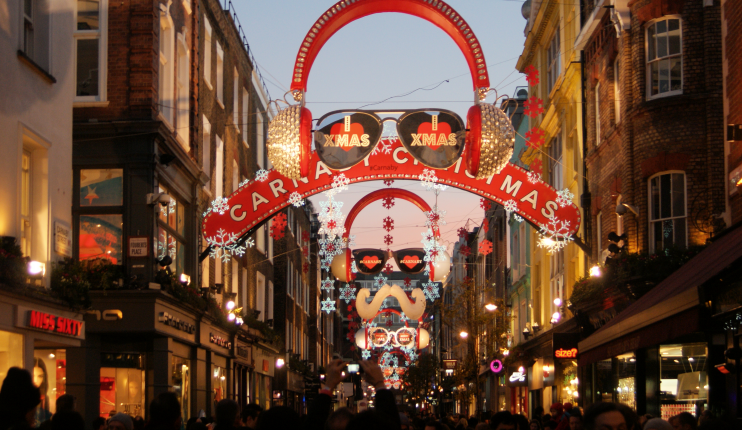Carnaby Street
Carnaby Street, Westminster
World famous in the 1960s, Carnaby Street is a pedestrianised shopping street running parallel with the middle part of Regent Street

The field here belonged to the abbot and convent of Abingdon until its surrender to the Crown in 1536. In 1590 Thomas Poultney acquired the lease and the land remained in his family’s hands for the next century. There was a windmill and an adjoining well somewhere in the field, perhaps on the site of Kingly Court in the early 17th century.
Carnaby Street was laid out in the 1680s and the first property known to have stood here was Karnaby House, built by bricklayer Richard Tyler. The house may have been named after the village of Carnaby in Yorkshire. A little colony of Huguenots formed the most conspicuous element among the street’s early inhabitants, most of whom were poor.
Tyler and his associates seem to have built to extremely low standards and all the original houses in Carnaby Street were rebuilt in the 1720s. Numbers 22, 23 and 40 survive from this phase, though they have since been refronted.
At the west corner of Foubert’s Place and Great Marlborough Street, the Shakespeare’s Head public house was probably established in 1735, allegedly by distant relatives of the Bard. It was completely rebuilt around two centuries later (a fact not mentioned on the pub’s website).
Carnaby Street and Newburgh Street were redeveloped c.1820 and more than a dozen houses in the vicinity of Lowndes Court and Marlborough Court survive from this period. However, they have all been significantly altered, mainly during their subsequent conversion to shops and in some cases during repairs to wartime bomb damage.
By the mid-19th century most of the street was given over to trades of various kinds. A number of the premises were subsequently converted to sweatshops working for the gentlemen’s outfitters in nearby Savile Row.
In the 1950s some of these tailors began to produce more distinctive garments for direct sale, including suits for the smartly dressed Mods of the early 1960s. Off-the-peg fashion retailers soon joined the party and within a few years Carnaby Street and its immediate neighbours had become world famous for their trendy unisex boutiques. At the height of ‘swinging London’ only Chelsea’s King’s Road offered serious competition.
Slow decline set in at the end of the 1960s, with periodic attempts to reverse it. Westminster council garishly refurbished the street in 1973 and during the 1990s local traders attempted to reposition the area as West Soho, with very limited success.
The street took a turn for the better at the beginning of the new millennium, offering an increasingly eclectic selection of clothes and accessories amid a dwindling proportion of gimmicky tat.
Having helped revive Carnaby Street’s credibility, several independent stores were then elbowed into the adjacent courts and sidestreets by major fashion retailers.
The locality’s principal landowner Shaftesbury plc has now branded the area ‘Carnaby’, within which the ‘trend-setting’ eastern part has been promoted as the ‘Newburgh Quarter’.
Shaftesbury recently embarked on a strategy to attract more flagship shops to the locality, leading to the arrival of trendy names like True Religion, Scalpers and Urban Decay on Carnaby Street, Traditional Weatherwear on Newburgh Street and ‘heritage footwear’ makers GH Bass at 35 Beak Street. Eyewear brand Ray-Ban opened a store at 23 Carnaby Street in 2018.
In addition to its plethora of fashion stores and ‘concept shops’, the Carnaby zone also boasts around 60 restaurants, cafés and bars.
“Everywhere the Carnabetian army marches on,” declared Ray Davies in the Kinks’ 1966 hit, ‘Dedicated Follower of Fashion’, but by 1977 the place was “not what it used to be” according to the Jam’s punky B‑side, ‘Carnaby Street’.
Postal district: W1
Further reading: Jeremy Reed, The King Of Carnaby Street: A Life of John Stephen, Haus, 2010
Survey of London: Kingly and Carnaby Street Area
Bing shopping map: Carnaby Village
